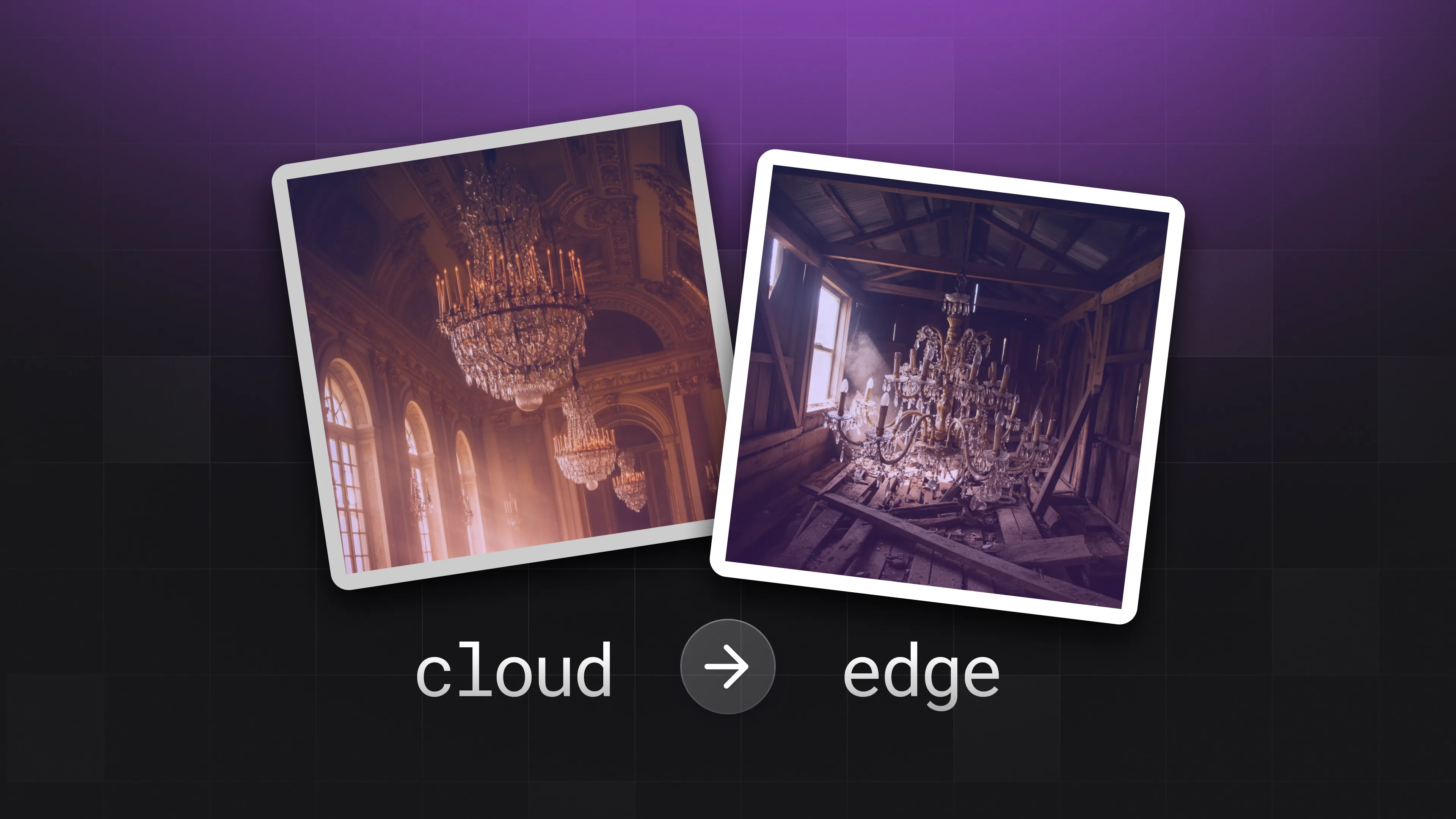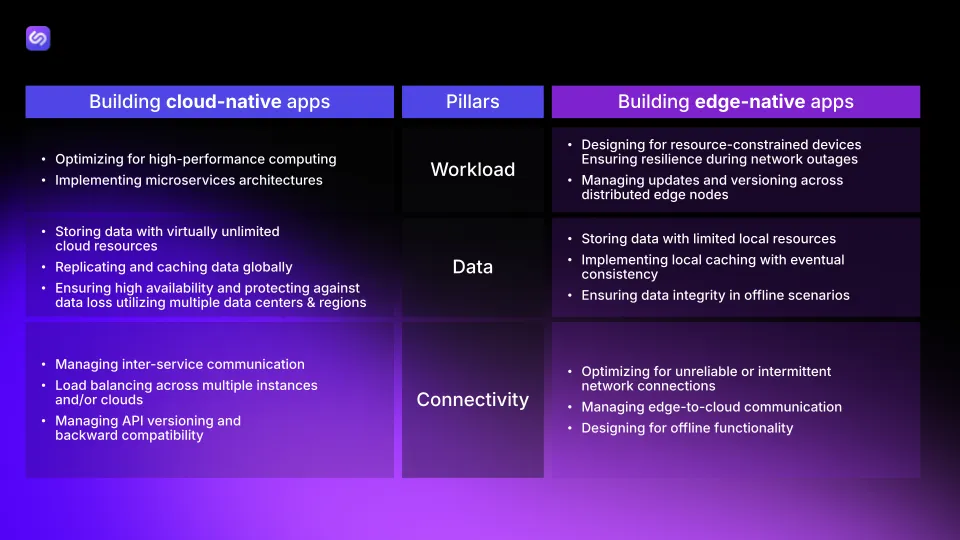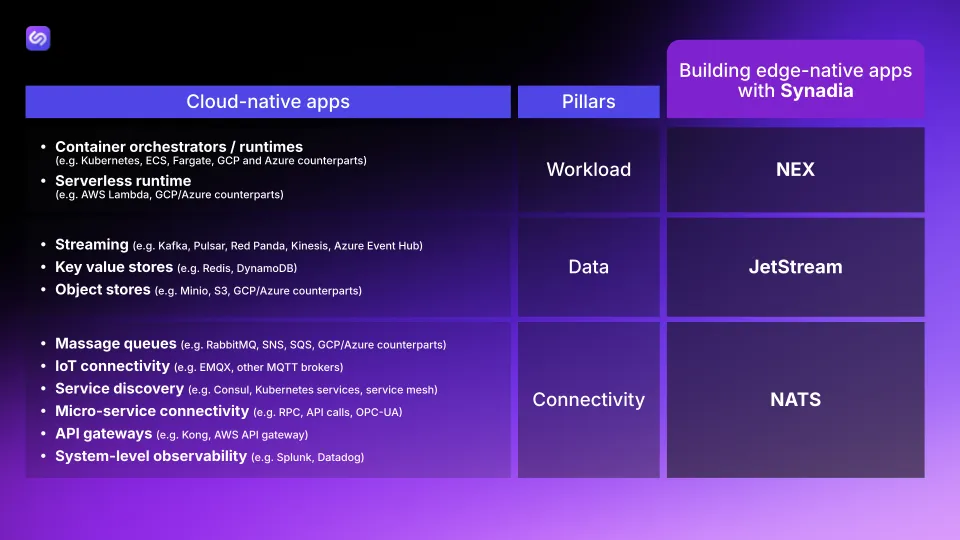You can't forklift apps from Cloud to Edge

If you’re building applications or experiences that will run at the edge, you must build for the edge. You wouldn’t try to move a crystal chandelier from a grand ballroom to a flimsy wooden shed: it would shatter into pieces.
Just like lifting and shifting applications from mainframe to virtual machine wasn’t a recipe for success, neither is fork lifting apps from cloud to edge. Your edge apps may be smaller pieces, but you definitely don’t want a shattered mess!
Cloud and edge environments are two different beasts
Cloud and edge environments could not be more different:
- Cloud: Abundant resources and supporting services; reliable connections with robust centralized security controls
- Edge: Far fewer resources and supporting services then cloud; intermittent networks with different security schemes and a broader attack surface
As edge computing is poised for explosive growth, businesses and developers must distinguish building for the cloud vs. the edge. IDC’s March 2024 forecast predicts global spending will hit $232 billion in 2024—a 15.4% jump from 2023—and reach $350 billion by 2027.
This surge reflects industries’ increasing need for faster, localized data processing and management. For comparison, the total global software sales annually were ~ $650 billion in 2023. Edge computing may already drive one third of global software spend.
Let’s explore this through two contrasting examples: Netflix (cloud-native) and Cruise Automation (edge-native).
Cloud-Native Example: Netflix (Video streaming service)
- Workload Layer: Microservices architecture for content delivery, user recommendations, and billing
- Challenge: Ensuring seamless service when individual components fail
- Solution: Sophisticated fault tolerance and service mesh implementations
- Data Layer: Global content distribution and user preference data
- Challenge: Maintaining consistent, up-to-date content across regions
- Solution: Advanced data replication and caching strategies
- Connectivity Layer: Millions of simultaneous streaming sessions worldwide
- Challenge: Balancing loads during peak viewing times
- Solution: Dynamic scaling and intelligent traffic routing
Edge-Native Example: Cruise Automation (Self-driving cars)
- Workload Layer: Autonomous driving software
- Challenge: Ensuring safe operation in unpredictable environments
- Solution: AI-driven local decision making, fail-safe mechanisms
- Data Layer: Global content distribution and user preference data
- Challenge: Managing vast amounts of data with limited onboard storage
- Solution: Edge analytics for immediate decision-making, selective cloud uploads
- Connectivity Layer: Millions of simultaneous streaming sessions worldwide
- Challenge: Maintaining critical operations with intermittent connectivity
- Solution: Robust local processing with occasional cloud syncs
Moving from cloud to edge requires a paradigm shift vs. a simple relocation.
- Netflix optimizes for global scale and consistent user experience, assuming reliable high-bandwidth connections
- Cruise Automation designs for split-second local decisions and autonomous operations, unreliable connectivity, and life-critical operations
This shift demands new architectures. This goes beyond changing where applications run; we’re transforming how they’re designed, built, and operated at each layer of the stack.

Synadia’s vision for Edge Computing
The transition to edge computing requires a fundamental reimagining of how distributed systems are built and operated. Synadia’s approach aims to bridge the gap between cloud and edge, addressing those unique challenges of edge computing while maintaining the agility and scalability of cloud-native architectures.
Key Points of Synadia’s Edge Tech Stack Vision:
- Simplicity and versatility: Synadia’s Tech Stack dramatically reduces complexity compared to traditional cloud-native architectures.
- Agility and speed: The stack rapidly innovates across global infrastructure. Imagine updating software across thousands of edge locations within 20 minutes vs. months.
- Flexibility and scalability: Applications built with this stack can transition between cloud and edge environments without major redesigns, addressing the “forklift problem” head-on.
- Reduced latency: Services and data move closer to where they’re needed, minimizing data “tromboning” (i.e. taking an inefficient, roundabout path between two points, increasing latency and resource use). This shift improves overall system performance.
- Unified approach: Instead of requiring different tools and expertise for each cloud provider or edge scenario, Synadia’s stack provides a consistent framework across all environments.
- Easy maintenance: The simplified architecture makes it easier to manage and update large-scale distributed systems, such as updating software across thousands of edge locations.
- Cost-effectiveness: By reducing complexity and required infrastructure, the stack aims to lower operational costs.
- Security: Synadia’s tech stack uses a zero-trust security model with secure interactions between applications, services, and devices across multiple cloud, edge, and on-prem environments. The outcome: robust protection against potential vulnerabilities.
- Data sovereignty: Synadia’s edge architecture ensures that data can be processed and stored locally. Organizations can comply with data sovereignty regulations by keeping sensitive information within specific geographical boundaries, reducing reliance on external cloud services and ensuring better control over data privacy and jurisdiction.
Synadia Tech Stack: A new way to build for the edge
Synadia’s tech stack, based on three key open source technologies: NATS, JetStream, and Nex, supports distributed systems architectures for edge computing, including AI at the edge. Here’s how it compares to traditional cloud-native approaches:

Instead of just about improving current cloud-native practices, Synadia’s approach fundamentally shifts how distributed systems are built and operated in an increasingly edge-centric world. This vision calls back to our initial analogy: just as a heavy chandelier isn’t suited for a shed where a lighter, more durable lamp would be better, your app’s tech stack must differ at the edge compared to in the cloud.
At the edge, it’s all about “batteries included.” Edge applications, like a reliable flashlight, must self sustain and operate in challenging environments. In the cloud, apps can rely on abundant external services and resources - like a chandelier connected to the electrical grid. At the edge, however, applications must be more self-contained and resilient, carrying their essential components with them - just as a reliable flashlight does.

This “batteries included” approach means edge-native apps are designed to:
- Operate independently for extended periods
- Handle intermittent connectivity gracefully
- Make efficient use of limited local resources
- Adapt to varying environmental conditions
Synadia’s tech stack embodies this philosophy, providing the necessary “batteries” for edge applications to thrive in resource-constrained, potentially disconnected environments. By including essential functionalities within the stack itself, Synadia helps developers create robust, self-sufficient edge applications requiring no external dependencies.
The future of distributed systems innovation
Synadia’s approach reimagines how businesses can innovate and scale. In the words of Synadia founder and CEO Derek Collison:
We allow companies to deliver innovation faster. Not to innovate faster, because innovation is you and me… it’s all the other pieces to get that innovation in front of our customers and partners. That’s the impact.
As an example, a global retailer using Synadia’s tech stack can scale a new customer order app to all its 30,000 stores globally, with just a few commands to push the new app to edge point-of-sale devices. Cutting out complex migrations and getting new software products operational in hours rather than weeks brings a significant competitive advantage.
With Synadia as their partner for edge-native and distributed computing, both startups and global enterprises are dominating whatever business they’re in by delivering their innovations faster and more efficiently. Ready to join their ranks? Get started with Synadia today.
